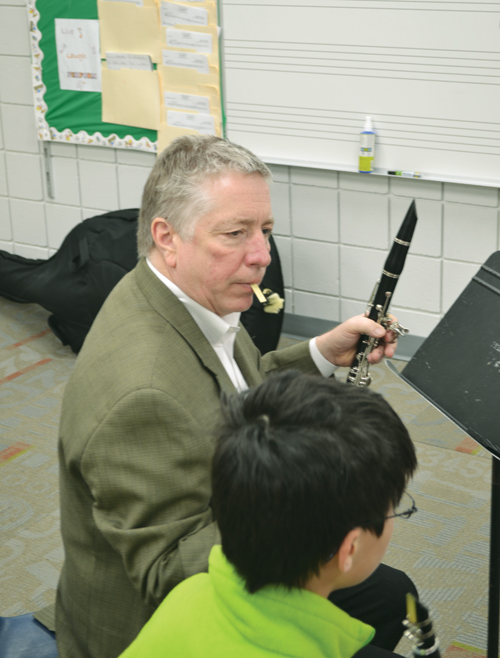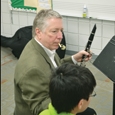
After graduating from Northeast Missouri State University (now Truman State), Tony Garmoe spent 29 years as a high school band director, including 23 years at Valley High School in West Des Moines, Iowa. A district reorganization opened up an opportunity to teach elementary band at two schools, Clive and Westridge Elementaries, and Garmoe made the switch. Here are his reflections on his high school career and his thoughts on his new position.
From your perspective as a long-time high school teacher, what are the most important aspects of musicianship to teach beginners?
It is important to teach young musicians how to read music well. Being a good music reader is essential. It is easy for everybody to spend a bit longer on one tune than we might need to, but it is important for students to develop their reading skills. It’s important to read and read. The more that we can have students play in keys other than Bb, Eb, and F, the better. In conjunction, as they move into middle and high school, it is important to begin working on such musicianship skills as how to listen to music and how to be a good member of an ensemble.
There can be great wisdom in incorporating unison exercises into the band rehearsal. These can be especially beneficial for low brass players. For example, it seems young tuba players see an inordinate amount of whole and half notes in elementary and middle school full band music (often high school, too). These students can develop technique just as well as trumpet players, but the way young band music is often constructed the tuba players end up with the harmonic and rhythmic pad. This can limit their technical development. We wonder why tuba players are often behind in their technical development, but I think we do it to ourselves.
What is the biggest adjustment you’ve had to make in switching to elementary band?
I enjoy the unbridled enthusiasm and newness of the experience for the young students. It is extremely rewarding being the one who gets to introduce students to band. That said, it is a different type of teaching. I’ve found myself missing adult contact, meaning adult, not just high school students. Faculty collaboration is more rare at the elementary level; it is students-in-students-out all day, and that was a big change for me.
Students’ pullout lessons are 30 minutes at Westridge, and at Clive they are 20-30 minutes. I start my week at Westridge. I teach fifth graders on Monday and sixth graders on Tuesday. On Wednes-day I teach fifth graders at Clive, and Thursday is Clive sixth graders. Friday I teach half a day of fifth grade lessons at Westridge in the morning. The fifth grade bands each have a 30-minute rehearsal once a week. Westridge meets on Mondays from 3:15-3:45, and Clive meets on Friday from 2:30-3:00.
I also co-teach a sixth grade band that meets before school two mornings a week for just under an hour. The band is called the Northside 6th Grade Band, and it consists of students from four elementary schools. I co‐teach this rehearsal with a wonderful colleague, Jerylin Kobberdahl. She is an outstanding teacher who has a vast body of experience with elementary students and elementary band. I learn from her every time we are together and count myself fortunate to collaborate as well as be under her tutelage. I feel our two approaches are complementary and the multiple perspectives provides the students a rich band experience. She is organized beyond imagination and I respectfully refer to her as “the master and commander of all that is the Northside 6th Grade Band.”
What activities do you do with the elementary bands?
The fifth grade bands take a small spring tour each year. I combine my two fifth grade schools into one band. We have one before-school rehearsal where we put everything together, and we’ll play once at Westridge and once at Clive. We also play an evening concert for the parents.
The sixth graders also have a tour concert in December, and they perform again in April. In between the two concerts we have sixth grade solo and ensemble festivals, and also handle chair placement. In addition, the sixth grade students are part of an all‐district marching band consisting of all grades 6‐12 band students that does a mass band standstill performance at ValleyFest, the local marching band festival. Everybody enjoys it, and it is good early exposure to the high school marching band. Sixth-grade tuba players use 3⁄4-size instruments with straps to help them carry the tubas while marching. The sixth-grade tuba players have never complained, and I get the impression they find it exciting.
What are the differences between students of high school age and students of elementary age?
High school students can be somewhat reserved, but when they are young, everything is new and exciting. When you’re a fifth and sixth grade band director, students love you. They bring you valentines and say thank you. It is an interesting experience.
Conducting for elementary students is more rudimental in its approach. It fills a bit more of a functional role in many cases; however, it is important to find times to connect students’ sense of where the phrase is going to what you’re doing with your baton and hand. The best opportunities at the elementary level are often dynamics, such as a long crescendo.
There are many similarities, too. Students need to be engaged and kept interested. They both need to have their musical growth fed and nurtured. You can tell very quickly if something is not going well in both elementary band and a high school band rehearsals.
What were the biggest lessons you learned throughout your teaching career?
As I review my career, one of the things I have come to value is the time the students are in the classroom. This is true not only for large ensembles but also for lessons. Rehearsal time is the opportunity to do the best teaching you can from bell to bell. Those are very valuable minutes, and anything you can do to be prepared to teach your students and share what it is you want to share on that particular day must be done. There can be no wasted time when you’re in front of students. Directors should have a detailed lesson plan, anticipate any possible places things can go off track, and be prepared to try something new if what they are doing isn’t working. Sometimes enough students are absent that on-the-fly adjustments have to be made, but not much else should be able to derail a well-planned rehearsal.
What are some of your favorite works for high school groups?
I have always been interested in literature and literature selection, both from a cultural and artistic standpoint and also in terms of students’ technical and artistic development as they move throughout the year and through their time in your program. Pieces like the Holst Suites and Lincolnshire Posy are time-tested standards that many, if not most, people would consider core to the band repertoire. Such compositions should be prioritized. We should play contemporary works as well, but the longer I was at the high school, the more I gravitated toward the great classics.
In my last year at Valley High School I programmed a great piece: Three Tragic Ballads by Percy Grainger. They are choral works arranged for band by Chalon Ragsdale, and truly wonderful music with mature musical and contextual demands. Another piece that stood out for me was Michael Colgrass’s Old Churches. It is an extremely interesting piece and makes a nice counterpoint to either of the Holst Suites. The majority of literature programmed should be rewarding for the students. It should have a body and soul that reveals itself to both the performer and listener over time.
Why is chamber music so important for students?
A strong chamber program is a wonderful way to teach musicianship skills and also one of the best ways to reach out to the community. We made this a point of emphasis when I was at Valley High School. It would not be uncommon for us to take 195-215 entries to solo and ensemble festivals in addition to playing at places in the community.
Chamber music is important for students because it forces them to take more responsibility for musical decisions, and any time we can get students to do that, it provides a deeper connectivity and a deeper level of music making. I always felt it was important to help students understand how much they could affect the music that was being made.
Sometimes getting students to that point meant pulling a chamber ensemble aside and saying, “We need to discuss this, and by ‘we’ I mean you and not me. One of you talk. Now the next person talks.” When it came to a point where I felt I needed to help the conversation, I would, but the goal was to help students make their own decisions by asking them questions.
Teachers get used to being the conductor and give out the answers and instructions. It almost becomes counterproductive because it teaches students to wait for the answer. It is better to guide students to finding answers and making decisions for themselves. The music becomes more exciting, and the audience notices.





